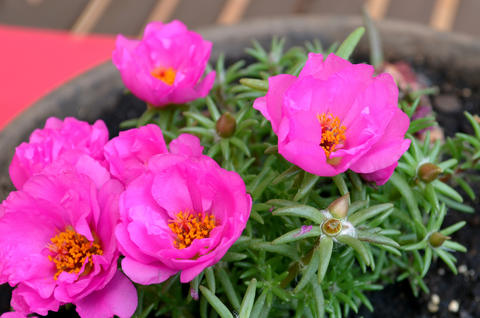Moss Rose
Whether on the balcony or in the flower bed: Moss Rose flowers captivate with vibrant colors in the sunshine. We advise you on the proper way to plant and care for these arid performers.
Factsheet
- Growth type
-
- Succulent
- one year old
- Growth height (from)
- from 10 cm to 15 cm
- Growth width (from)
- from 10 cm to 15 cm
- Growth characteristics
-
- overhanging
- flat growing
- carpet forming
- Flower color
-
- purple
- yellow
- orange
- red
- pink
- white
- multicolored
- Flowering time (month)
-
- June to August
- Flower shape
-
- Shell Flowers
- Flower characteristics
-
- lightly fragrant
- Leaf color
-
- green
- page format
-
- lancéolées
- needle-shaped
- Fruit shape
-
- Capsule
- Light
-
- sunny
- Soil type
-
- stony to sandy
- Soil Moisture
-
- dry to moderately dry
- ph value
-
- neutral to weakly acidic
- Nutrient requirements
-
- moderately nutritious
- Decorative or utility value
-
- Flower Decoration
- Leaf ornaments
- Use
-
- Flowerbeds
- ground cover
- Borders
- Planters
- Garden style
-
- Flower garden
- Roof Garden
- Stone Garden
- Pot garden
- Bee Friendly
- bee friendly plant
Moss rose (Portulaca grandiflora) is a species of plant from the Portulaca genus and belongs to the Portulacaceae family. The succulent grows on extremely sunny, dry, and sandy slopes in its native Argentina, Brazil, and Uruguay. Although the moss rose originates from South America, it has been partly naturalized in central and southern Europe.
The bushy summer flower grows between 3.94 and 5.91 inches tall and the flat, decumbent shoots spread out rapidly. The annual plant looks fantastic in window boxes and hanging baskets due to its wide, over-hanging growth.
The lanceolate, fleshy, thickened leaves of Portulaca grandiflora appear dark green and somewhat wavy. As the needle-shaped, 0.39 to 0.98 inch long leaves can store water and nutrients well, the succulent plant can also survive stressful summer phases.

The large, rose-like flowers of the moss rose are enchanting from June to August. They often grow in pastel shades, but also with strong tones. The color palette ranges from white to yellow, orange, and pink, to red and violet. And the entire color spectrum can also appear in a single plant. The flowers have a diameter of around 1.57 inches and, as a rule, only open in the sunshine. Dense, golden yellow stamens appear between the delicate, bowl-shaped broad spread and silky shimmering petals. The flowers are particularly abundant during warm, dry summers. There are also double-flowered versions. Some varieties have a sweet evening fragrance.
Portulaca grandiflora forms capsules. They contain tiny seeds and appear gray-black to black.
The frost-sensitive Moss Rose needs a place in a fully sunny, rain protected position to be able to show its full flowering capacity. The flowers do not open at all or only partially on dull days. As a container plant, Moss Rose is happy on sunny patios and south-facing balconies.

The substrate should be loose, well drained and rich in nutrients. Ideally, a light cultivated substrate should be mixed with about a third of sand. Make sure to create a drainage layer before placing the moss rose in a planting container with sandy-humus substrate. In this way, you can avoid harmful waterlogging.
Moss Rose can manage with low moisture levels and only requires a little watering. The succulent plant can compensate well for irregularities in the water supply using the reserves stored in its fleshy leaves.
Moss Rose is also very undemanding where the nutrient supply is concerned. Providing Portulaca grandiflora with a weak dosage of fertilizer every four to six weeks is absolutely sufficient.
Regularly remove withered plant parts from the moss rose. This stimulates the formation of new flowers.
The modest Moss Rose is perfect for adding greenery to pots, boxes, and bowls in sunny locations. It looks particularly decorative in hanging baskets, as its shoots like to overhang. If you would like to combine Portulaca grandiflora with other plants, choose species that also have a low water requirement. Suitable companions include gazania or Livingstone daisy (Dorotheanthus). These are not only color coordinated, they also tolerate strong sun and heat. Moss Rose is also suitable as groundcover or as a border plant in flower beds and rock gardens. Despite its low growth, the flowering beauties also look decorative without companions.

Whether double, semi-double or single flowers: There are numerous varieties and mixtures of Portulaca grandiflora. Varieties from the ‘Margarita’ series are densely double-flowered. ‘Sundance’ is a color mixture of semi-double flowered, long opening flowers. Varieties from the ‘Sundial’ series are recommended, depending on the desired colors. Portulaca grandiflora ‘Sundial White’ charms with white flowers, ‘Sundial Gold’ is luminous in radiant yellow, ‘Sundial Chiffon’ in pink and ‘Sundial Fuchsia’ in hot pink.
Moss Roses are generally grown from seeds. Pre-cultivation is recommended indoors between March and May. Young plants should be kept moist during breeding and fertilized every three weeks. Planting three to five seeds in each pot saves pricking out. You can sow directly in the desired planting container, such as the balcony box, from the middle of May. If the small plants are cut back once they will grow bushier. You can plant the frost-sensitive young plants outdoors from the end of May at 5.91 inches apart. Alternatively, you can root cuttings in the summer that overwinter at 50 to 59 degrees Fahrenheit.

